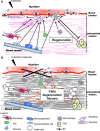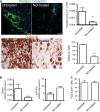Fat deposition and accumulation in the damaged and inflamed skeletal muscle: cellular and molecular players
- PMID: 25854633
- PMCID: PMC11113943
- DOI: 10.1007/s00018-015-1857-7
Fat deposition and accumulation in the damaged and inflamed skeletal muscle: cellular and molecular players
Abstract
The skeletal muscle has the capacity to repair damage by the activation and differentiation of fiber sub-laminar satellite cells. Regeneration impairment due to reduced satellite cells number and/or functional capacity leads to fiber substitution with ectopic tissues including fat and fibrous tissue and to the loss of muscle functions. Muscle mesenchymal cells that in physiological conditions sustain or directly contribute to regeneration differentiate in adipocytes in patients with persistent damage and inflammation of the skeletal muscle. These cells comprise the fibro-adipogenic precursors, the PW1-expressing cells and some interstitial cells associated with vessels (pericytes, mesoangioblasts and myoendothelial cells). Resident fibroblasts that are responsible for collagen deposition and extracellular matrix remodeling during regeneration yield fibrotic tissue and can differentiate into adipose cells. Some authors have also proposed that satellite cells themselves could transdifferentiate into adipocytes, although recent results by lineage tracing techniques seem to put this theory to discussion. This review summarizes findings about muscle resident mesenchymal cell differentiation in adipocytes and recapitulates the molecular mediators involved in intramuscular adipose tissue deposition.
Figures


References
-
- Charge SB, Rudnicki MA. Cellular and molecular regulation of muscle regeneration. Physiol Rev. 2004;84:209–238. - PubMed
-
- Kuang S, Rudnicki MA. The emerging biology of satellite cells and their therapeutic potential. Trends Mol Med. 2008;14:82–91. - PubMed
-
- Relaix F, Zammit PS. Satellite cells are essential for skeletal muscle regeneration: the cell on the edge returns centre stage. Development. 2012;139:2845–2856. - PubMed
-
- Seale P, Sabourin LA, Girgis-Gabardo A, Mansouri A, Gruss P, Rudnicki MA. Pax7 is required for the specification of myogenic satellite cells. Cell. 2000;102:777–786. - PubMed
Publication types
MeSH terms
Substances
LinkOut - more resources
Full Text Sources

